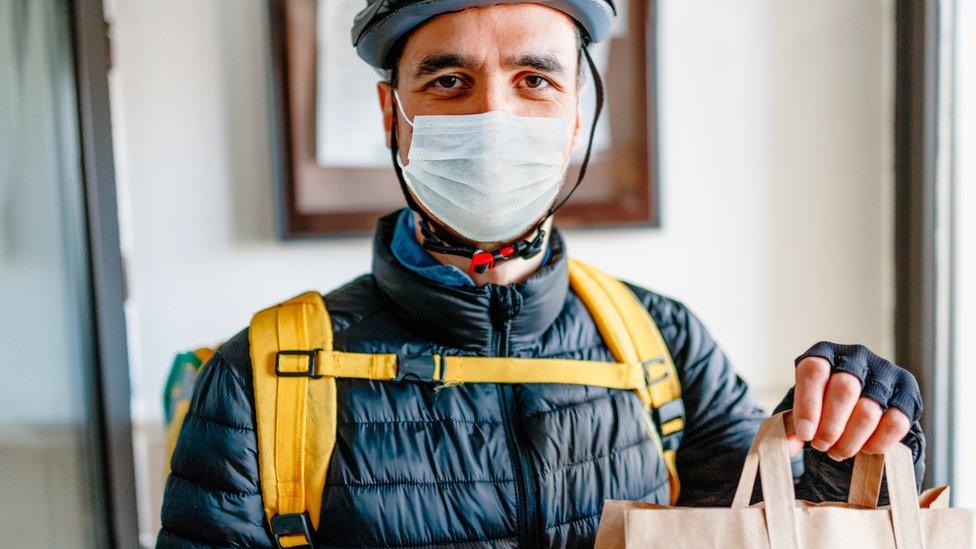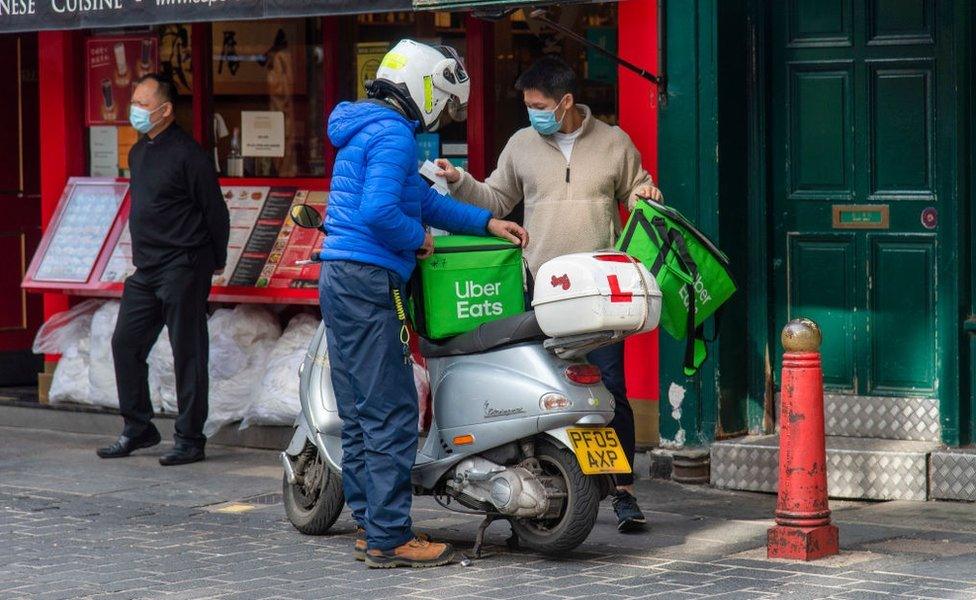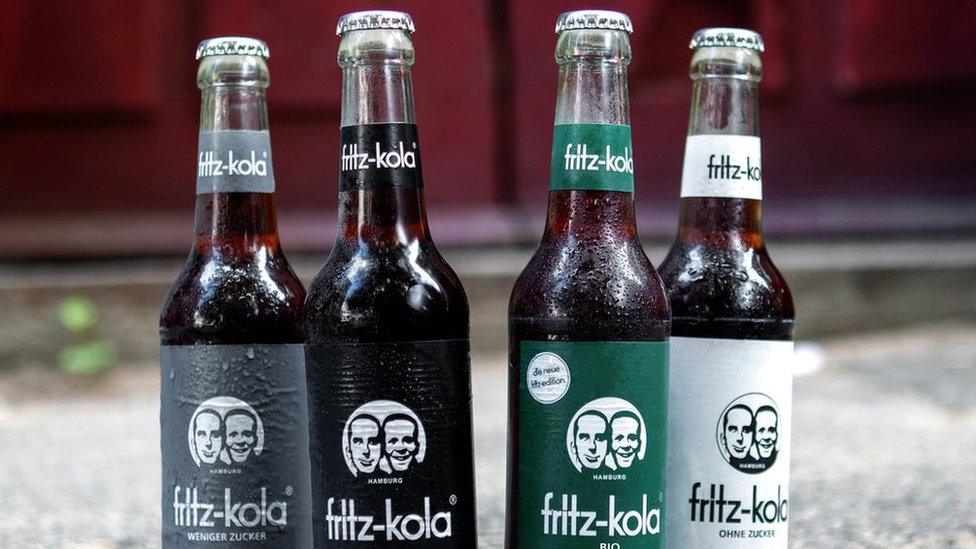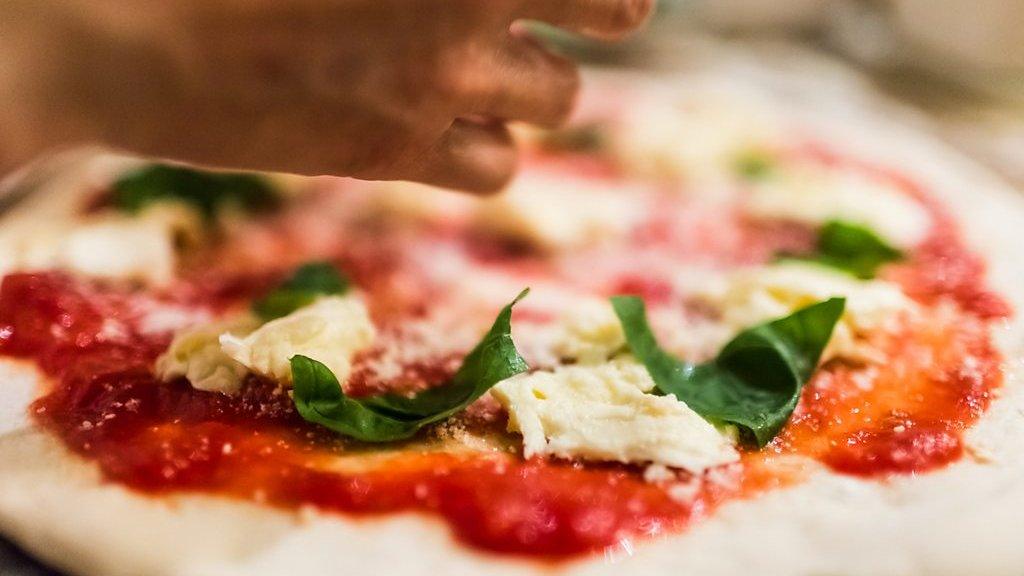Should you tip the takeaway delivery driver?
- Published

Musician Jonathan Clarke started delivering food after Covid meant his concerts were cancelled
The volume of takeaway food deliveries has soared this year as the pandemic has closed restaurants. But should you tip the delivery driver? We take a look at the correct etiquette on your doorstep.
Jonathan Clarke says that about a quarter of households will give him a tip.
The classical musician started delivering food by bicycle for the Deliveroo app in the summer.
He took the job after a number of his concerts were cancelled because of Covid. "The reality was that I'd lost the majority of my income," says the 43-year-old.
"And I love cycling, so Deliveroo seemed the obvious thing to do."

Food delivery orders have soared this year
While still teaching a number of music lessons, he delivers everything from chips to champagne around the towns of Hemel Hempstead and Berkhamsted, north west of London.
Mr Clarke earns about £70 per week from Deliveroo, plus tips. He says the most he has received is £2.
On one occasion he cycled three and a half miles uphill, carrying kebabs, pizza, chips and large bottles of soft drinks - only to be tipped just 75p.
But given the financial uncertainties many of us now face as a result of the pandemic, he understands that lots of people are having to watch their pennies. "You're generally not delivering to people who've got money to splash around."
Mr Clarke adds: "The only people who tip me are the ones who have had the door open and been waiting for me. They see me on my bicycle and ask me how far I've come, how bad the journey has been.
"Usually they've had a long day at work, and see it's been the same for me."

Food delivery apps such as Uber Eats have greatly increased their market share
Figures show the UK's takeaway delivery sector has boomed since the start of the first lockdown on 23 March. In the 24 weeks to 6 September, takeaway deliveries totalled £3.2bn, according to data given to the BBC by the government's Agriculture & Horticulture Development Board, and research group Kantar.
That is up from the £1.2bn figure for the 24 weeks to 22 March.
Perhaps more strikingly, the two organisations say that in February 84% of Britons went to collect their takeaway themselves, external, falling to 41% in May. Of the 59% of takeaway meals delivered in May, 18% were from telephone orders, 21% were via a so-called "aggregator" app such as Deliveroo or Just Eat or Uber Eats, and 20% were via a restaurant or the takeaway's own app or website.
The share for the aggregators had tripled from 7% in February. To help fuel this boom in demand, Deliveroo is doubling its number of UK delivery drivers this year from 25,000 to 50,000.
But whether you hand over extra cash when the driver arrives or tip via the app - as some now allow - should you do so? And if so, how much?

Deliveroo previously only allowed tips to be made before a delivery
Etiquette coach William Hanson says tipping food couriers in the UK is a more recent concept, imported from the US about 10 years ago.
"America is a country where they tip for everything, and always has been, with money being a key motivator [as tips are a key part of earnings]," he says.
"Whereas Brits view a tip as having to be earned - something which is not a given. We would only give a tip if someone has given good service, or gone above and beyond what they would be expected to do for their salary."


New Economy is a new series exploring how businesses, trade, economies and working life are changing fast.

However, the rise of food delivery apps has made tipping "more widespread" in the UK, he says.
Uber Eats says the average tip has risen by more than 30% in recent months, while on Deliveroo it doubled from March to September.
Yet the numbers of people tipping the food delivery staff in the UK still trails behind the US.
While Jonathan Clarke in Hemel Hempstead says only a quarter of people tip him, Daniel Kuehn, an Uber Eats driver in Houston, Texas, says 90% of his customers do, via the app.

Daniel Kuehn has been working as an Uber Eats driver for the past two and a half years
Uber Eats and Deliveroo both now allow users to tip electronically either before or after delivery, and the worker gets to keep the full amount. Just Eat does not yet allow in-app tipping.
Deliveroo had previously only allowed people to tip at the point of order, which had come in for criticism. One academic study in the US questioned whether asking for a tip up front was "manipulative", external and led to customers being less generous because they were unsure of the level of service they would receive.
Mr Kuehn, who recently reached a big work milestone - 4,000 food deliveries for Uber Eats - says the biggest tip he has received was $30 (£23) at the height of the coronavirus pandemic.
Overall, his customers have been more generous since the first lockdown with tips now $5-$10, up from $2-$3 previously, he says.
"A lot of people messaged me saying, 'I really appreciate you being out there, and what you're doing,'" he says. "I definitely think that had something to do with the amounts being a little bit higher."
US etiquette expert Elaine Swann says for as long as the pandemic continues, it is best to try to tip takeaway drivers electronically if possible.

Etiquette expert Elaine Swann recommends tipping at least 10%
"My recommendation is to utilise the technology that the apps provide for the tip. That way you don't put [the driver] in an awkward position to refuse touching the cash.
"If you do not want to for whatever reason, I would put that tip inside an envelope or sandwich bag and hand it over to them."
She recommends starting at 10% for a tip, and adding a little bit more if you can afford it.
"These individuals are not only providing a luxury service for us, but now they're putting themselves and their health on the line."
But Ms Swann does appreciate that money may be tight for many people during the coronavirus crisis. She says that "sharing a kind word" or a smile with a driver can be enough, if finances are stretched.
"We have to make sure we're treating each other with humanity," she says. "It's important anyway, but more so today."
However, back in the UK, takeaway delivery driver Zaid (who did not wish to share his surname) says any tip would be a good thing.
He delivers for independent restaurants in Maidenhead, west of London.
"Hardly anyone tips," says the 21-year-old. "If you work full-time for a week you are lucky to get £1 from anyone."
- Published17 August 2020

- Published22 May 2017
